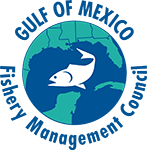![]()
| Additional Rules |
|---|
|
Vessel Monitoring Systems are required onboard all vessels with federal commercial permits for Gulf reef fish, including charter vessels/headboats that also have a commercial reef fish permit.
|
|
Entangling nets may not be used for directed harvest of reef fish.
|
|
Reef Fish taken under recreational bag limit may not be sold.
|
|
Commercial vessels are prohibited from retaining reef fish caught under the recreational size and bag/possession limit when commercial quantities of Gulf reef fish are on board.
|
|
Reef fish gear is limited to no more than 3 hooks in a special management zone off Alabama. Nonconforming gear is restricted to bag limits, or for reef fish without a bag limit, to 5% by weight of all fish onboard.
|
|
Vessels with shrimp trawls or entangling net gear onboard may not exceed the recreational reef fish bag limits.
|
|
All fish except for bait and oceanic migratory species taken from federal waters must have heads and fins intact through landing. Up to 1.5 pounds of legal finfish exempt from this rule for personal consumption at sea provided the vessel is equipped to cook such finfish.
|
|
A state may regulate vessels that are registered in that state and that are fishing in federal waters for species for which there are no federal fishery management plans or applicable federal regulations.
|
|
Operators of vessels with Gulf of Mexico reef fish commercial or charter vessel/headboat permits must comply with guidelines for proper care and release of incidentally caught smalltooth sawfish and sea turtles and possess onboard specific gear to ensure proper release of such species.
|
|
There is no limit on the total number of hooks kept onboard bottom longline vessels, however, the number of hooks rigged for fishing is limited to 750.
|
| Two-Day Bag Limit |
Persons on qualified charter vessels or headboats on trips in excess of 30 hours may possess a 2-day bag limit of reef fish, king mackerel, and Spanish mackerel at any time during the trip. The for-hire vessel must have two licensed operators aboard, and each passenger must have in their possession a receipt issued to them on behalf of the vessel that verifies the length of the trip. One-day bag limits apply to all other species and trips, regardless of length. (Effective March 26, 2021)
|
| Head & Fins Attached |
All fish, except for bait and oceanic migratory species, taken from federal waters must have heads and fins intact through landing. Up to 1.5 pounds of legal finfish per person is exempt from this rule for personal consumption at sea, provided the vessel is equipped to cook such finfish.
|
| Federally Permitted For-Hire Reef Fish Vessels |
Federally permitted for-hire reef fish vessels must comply with the more restrictive of federal or state reef fish regulations when fishing for reef fish in state waters.
|
| Reef Fish as Bait |
The use of federally managed reef fish as bait is prohibited.
|
| Gear |
Reef fish gear is limited to no more than 3 hooks in a special management zone off of Alabama. Nonconforming gear is restricted to bag limit. For reef fish without a bag limit, nonconforming gear is restricted to 5% by weight of all fish onboard.
|
| Sale of Recreationally Caught Reef Fish |
Reef fish taken under the recreational bag limit may not be sold.
|
| Care and Release of Incidental Catch of Smalltooth Sawfish and Sea Turtles |
Operators of vessels with Gulf of Mexico reef fish commercial or charter vessel/headboat permits must comply with guidelines for proper care and release of incidentally caught smalltooth sawfish and sea turtles and must possess onboard specific gear to ensure proper release of such species.
|
| No Bag/Size Limit |
Check for applicable state regulations
|
| Persons on Commercial, For-hire, and Private Recreational Vessels |
Must have a venting tool or descending device rigged and ready to use when fishing for reef fish species in Gulf of Mexico federal waters.
|
The Management Areas Tab is under construction.
Thank you for your patience as we develop a dynamic mapping tool. In the meantime, please visit the Official Codified Fishing Regulations (eCFR) webpage for information.
Coral and Other Species |
|
| Live Rock |
Harvest or possession of wild live rock is prohibited. Harvest and possession of aquacultured live rock requires a permit.
|
| Other Marine Life Organisms |
Marine life organisms from the EEZ harvested or possessed by Florida residents or landed in Florida are subject to Florida’s Marine Life Rule. Contact Florida Fish and Wildlife Commission for more information 850-488-4676.
|
Highly Migratory Species |
|
| Tunas, Billfish, Swordfish, Sharks |
For Highly Migratory Species Compliance Guide Visit: https://www.fisheries.noaa.gov/atlantic-highly-migratory-species/atlantic-highly-migratory-species-fishery-compliance-guides
|
Disclaimer: These regulations are prepared for general purposes and have no legal force or effect. Visit the eCFR for official regulations.

